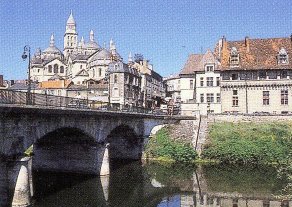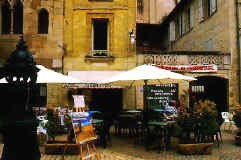| |
 |
The Region |
|
|
 |
Activities |
|
|
|
|

 |
If you walk up the hill from La
Cité you'll come to Cathedrale St-Front which proved to be a
trial run for architect Abadie who later went onto design the Sacré-Coeur
in Paris. Medieval and Renaissance architecture also includes
the Maison Estignard, no 3 rue Limogeanne and the Maison du
Patisser at place St-Louis. |
La Cité, once a pivotal
Gallo-Roman site of Vesunna, is also worth a foray. Although
this is largely a residential area you'll still see vestiges of the
Roman amphitheatre, a temple and the 12th century Eglise St-Etienne. .
|

|
 |
Perigueux is the capital of
the Dordogne and serves as a great base for exploring the surrounding
area. The medieval part of the town comes alive on Wednesdays
and Saturdays when local artisans display their first-class produce
including assorted cured meats, truffles, foie-gras and pies or 'pates
de Perigueux'. |
History
Founded over two thousand years ago, Périgueux,
préfecture or capital city of the Dordogne, is a gracious blend of ancient and
modern.
The history of the city of Périgueux began when four Celtic tribes merged to
become the Petrucores. They settled on the hills overlooking the river (l’Isle)
until they were overpowered by the Romans.
The Gallo‑Roman remains show how magnificent the town would have been in
the 1st and 2nd centuries, the Romans having built in the valley Vesunna, an
imposing city (between 15 and 20000 inhabitants), which, in the 3rd century, was
enclosed by a defensive surrounding wall.
In the 4th century, Vesunna which was but a small town was named after its
people “Civitas Petrocoriorum”. The town was no longer prosperous during the
Dark Ages. In the 9th century, it withstood the attacks of the Normans several
times thanks to its thick defensive surrounding wall.
From the 10th century on, the birth of another town gave new impetus to the
valley. As a matter of fact, a chapel and a monastery were built outside the
walls were the tomb of the apostle of the Périgord, whose name was Saint-Front,
had been erected and which attracted a lot of pilgrims.
Merchants, artisans who wanted to get
rich traded with the clerics and travellers and settled down nearby. This
population gave birth to the “Bourg du Puy Saint-Front”. In the 13th century,
the new town expanded and was surrounded by a wall in a U-shape, a 1.6 km long
with 28 towers and 12 gates.
In 1240, in the reign of Saint-Louis, the City and the “Bourg” met and
formed one city called Périgueux. For centuries, Périgueux, protected by its
defensive wall, remained unchanged. But from the 18th century on, the city began
developing. Beyond the wall a modern city appeared and in 1790 it became the
“préfecture” of the “département de la Dordogne”.
In the 19th century, the number of inhabitants increased a lot and the city
spread along the river Isle as it used to be in the 2nd century. But it is only
when the rail went through Périgueux in 1856 that the city really expanded
(5700 inhabitants in 1801, 13000 inhabitants in 1850, 31300 in 1890).
In the 20th century, “Great Périgueux”
developed through the neighbouring villages, going past the loop of the river
Isle. “Great Périgueux” is composed of 9 “communes” and has, according
to the population census made in 1999, about 65000 inhabitants whereas Périgueux
itself has about 32500 inhabitants
|
|
 |
Language |
|
|
 |
| . |
 |
|
|